Confession: I’m an unapologetic Tolkien fan. This will get geeky.
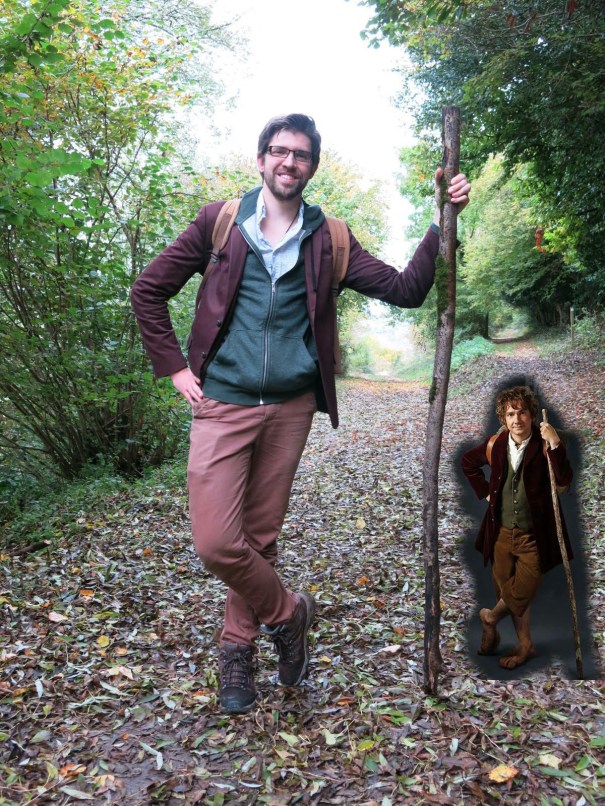
(This outfit choice was not accidental.)
That’s an understatement. The man basically shaped modern fantasy and literature as we know it and he did so in the interest of linguistics and mythology, rather than in the name of sounding smart, proving a point, building a franchise, or anything else. It’s easy to call people heroes, legends, etc but I think I count him as a personal hero and inspiration.
(This will come as no surprise to anyone who’s read my blog before. Or has met me.)
I read The Lord of the Rings around the time the films came out, starting them in 2001, shortly before the first film was released, then taking a two year hiatus and furiously trying to finish them before the third film came out. I loved them, but as I always find to be the case, although the books are longer, more detailed and more immersive, as the years go by the films tend to overwrite the books in terms of your memory, especially if you have the tendency to rewatch then with the frequency I have done.
(Same goes for Harry Potter: I only remember a few differences between the books and films now, mostly that Percy Weasley was a bigger deal in the books, Kreacher the house elf was excellent in book 7, and that in the fifth book Harry is really angry all the time and shouts in CAPITAL LETTERS.)
So last year I was proofing and editing my second novel in my All Worlds Unseen fantasy series (a saga I hope owes no obvious debt to Tolkien but I suspect owes several unconscious ones), and I wanted to have something to read that I was familiar with, so I could divert the bulk of my limited grey matter into the editing process. I’m not gonna lie, it was mainly an excuse.
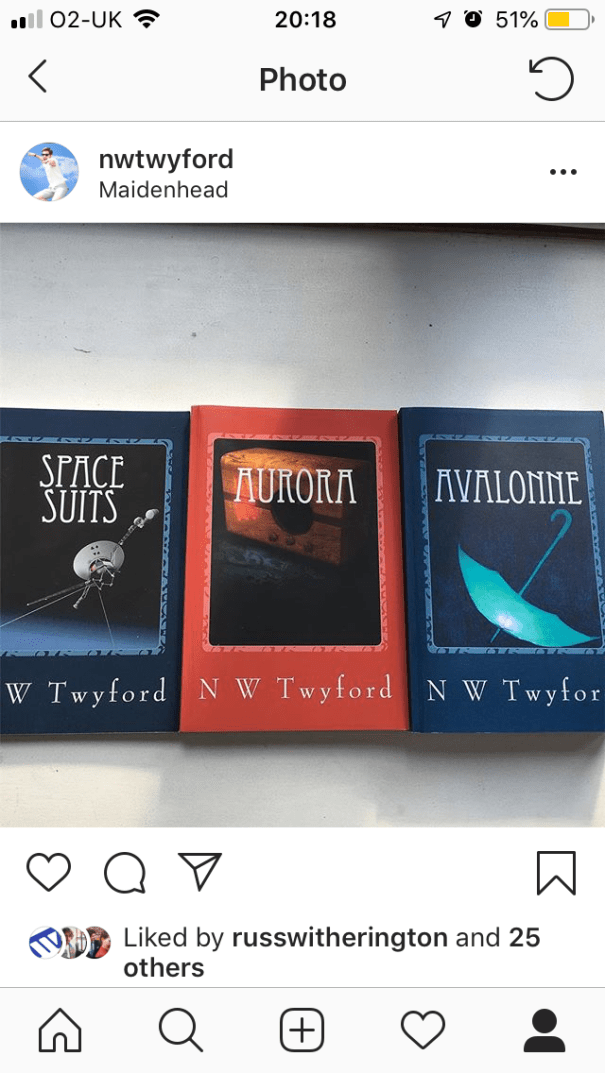
(These books may or may not be available to buy, by the way. There’s a shop page on this site. Just saying.)
So I start the re-read and around this time, my mate James and I start talking about it and he mentions that he’s never read them, and buys a copy, and we start a book club of two, sharing where we are over WhatsApps, mostly during our commute. Turns out he reads unsettlingly quickly, which does me no favours as I’ve decided to download the LotR wiki app in order to look up things in Middle Earth which I am unfamiliar with (don’t ask. I’m not sorry I did it.)
The app was great but probably a step too far. I’m pretty familiar with the world, having also read The Hobbit, The Silmarillion, Unfinished Tales, Children of Hurin and Tales of the Perilous Realm.

That’s all though.
Anyway, the reason I downloaded the app is the reason I’ve written this, and I suppose the reason you’re reading it. Because there’s lots going on in these books that the films miss out. I don’t blame them; some of the stuff omitted is great, some odd, and some is just not really needed for the film. I believe Jackson, Walsh and Boyens ethos in adapting the novel, which I completely understand and respect, was that if it wasn’t essential to the plot of Frodo and the Ring, then was it really needed? If that’s correct and I didn’t make it up, then fair play.
So for reasons that are – I’m pretty confident to say – rather geeky, I started documenting these differences. Not obsessively, I hasten to add, but just where whole scenes were removed or changed a lot. It’s not intended to be definitive, more of an aide memoir, and because it was interesting rather than because I thought “Hey, I could blog the crap out of this!”
The first book, Fellowship, I found to be the most different from the films, because I suppose the story only really gets going halfway through.
The results I think are quite interesting. It was nice having James on hand to read with, as he definitely fits that layperson balance that stopped me disappearing any further into nerdvana (not a word).
I should probably add that my observations are in no way intended to criticise Tolkien’s work. The man is one of the greatest writers of all time (you’ve said that already Nick, get on with it) and his influence on fantasy and storytelling in general can’t be measured, at least not by plebs like me. This is more like a stuff I found interesting or funny list.
Clear? Good.
The Fellowship of the Ring:
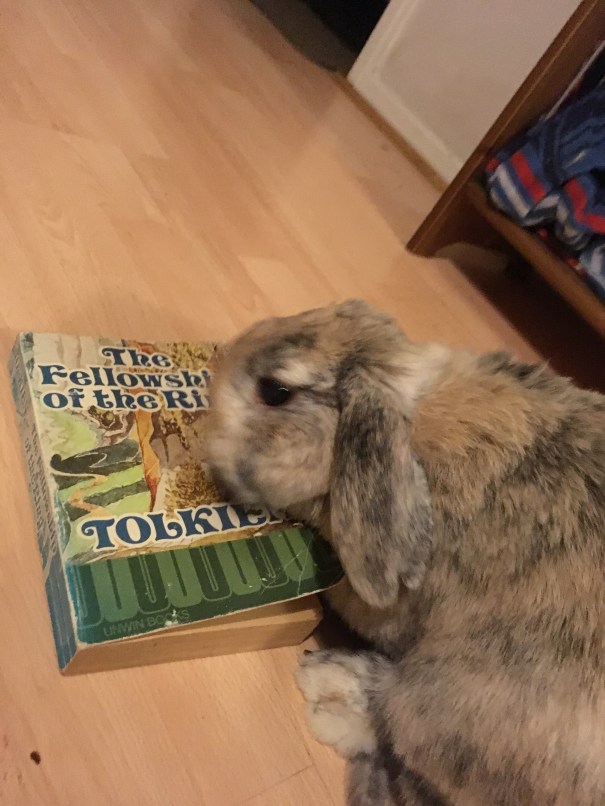
(I got Carrie to help me with the photos for the individual book sections to keep this visually stimulating. She was a bit of a diva about it if I’m being honest.)
Also, the copy of Fellowship I own is so old it had these in them:

(Fingers crossed for the clock radio!)
So, I’m not gonna lie. The start of Fellowship is a hard read. The book opens with a ridiculously long and detailed history on hobbit geneology, including notes such as how they evolved, are one of three similar species, how their society works, and so on. As someone familiar with hobbits I can comfortably say I didn’t need to read this and found it tough to get through. I wonder how people found it when the book was first released. Their only exposure to hobbits at this point would have been The Hobbit alone, whereas hobbits are now as big a part of pop culture as elves, dwarves and dragons. I’m not gonna say much more than that because it was a bit of a slog, but you can’t deny the man knew what he was writing about.
The next change that surprised me was that there are seventeen years between Bilbo leaving and Gandalf twigging that the ring is The Ring. In the films it’s practically overnight. Clearly book Gandalf smoked more of the halfling’s leaf than film Gandalf. This makes Frodo fifty by the time he starts his quest. I know Elijah Wood doesn’t really age, but that’s still pushing it.
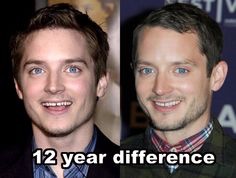
(Hmm. Maybe not.)
When Frodo is told of what he must do, in the films he’s off pretty much then and there. In the book, he arranges a quiet withdrawal from the Shire so no one suspects what he’s doing. This includes putting Bag End on the market and it takes a while to sell. For some reason this cracks me up. It’s just so Very British.
Turns out Merry wasn’t even part of the original crew of hobbits, Fatty Bolger is. What a name! Fatty stays behind in Frodo’s new (non Bag End, outside of Hobbiton) property. I think that was probably for the best.
Farmer Maggot is actually a pretty decent bloke who does everything he can to stop the boys from getting caught by the black riders. (As opposed to a walking pitchfork in the film.)
There’s a whole section where the four hobbits, before meeting Aragorn, get set upon by something called Barrow Wights while crossing the woods. They’re grim ghost things with no apparent link to the Nazgul but nearly end Frodo and co. before they even get to Rivendell.
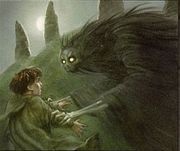
(This would take like an hour of screen time if it happened in one of the Hobbit movies.)
Speaking of omissions, a really big one is in the first half of the first book, and you can see why:

Tom Bombadil.
Tom. Effing. Bombadil and his fit wife. Worth a google if you’ve not heard of him before. He’s like a sort of immortal Hobbit (but not a hobbit) that might be older than Sauron and has no interest in the Ring. Later, the council discuss if they could hide the Ring somewhere and Bombadil is mentioned, to which Gandalf says that he’d only forget he had it.
There’s an amazing article that theorises dark things about old Tom that my mate John (him from the hike posts) sent me. You can read it here (it’s probably better than this post, so enjoy.)
Tom Bombadil. You can see why they cut him out.
Interestingly in the films they give some of his lines to Treebeard, because a walking tree-man is less weird than Bombadil. Go figure.
A character who probably shouldn’t have been cut out is Glorfindel, the most slighted character ever. Glorfindel is partially responsible for saving Frodo after he’s stabbed on Weathertop (he puts Frodo on his horse, whereas in the film Arwen has this role and rides with him) and later is suggested by Elrond to be the ninth member of the fellowship instead of Pippin. Gandalf rejects the notion saying that Glorfindel is too strong and stealth is better. Maybe they should have substituted him for Boromir considering how things panned out.
Anyway, you can see why they upped Arwen’s role for the film; she doesn’t really get a look in in the books, and Eowyn aside, it’s a bit of a sausage fest.
Still, bit harsh cutting him out of the movie to the extent he’s basically an extra. I thought he was cool.
Bill the Pony is mostly cut from the film, too. He’s great. Bill is rescued from some odious bloke in Bree and he and Sam have a really sweet bond. Bill is sent back when they get to Moria which is probably a good thing.

(Says on this card here Bill cannot have attachments. I suppose when you’ve got hair like his your life is just wall to wall action.)
The rest of the changes to Fellowship made by the films are slightly more cosmetic:
We learn that Gollum had been caught by Gandalf and Aragorn and got free before being caught by the Enemy and doing that whole “Shire!… Baggins!” bit. I can only assume talking about Gollum is less interesting than actually seeing Gollum, so they held back until Two Towers to introduce him properly.
We see that Frodo owning the ring kinda gives him super senses. It’s never really explicitly hammered home or made into a plot point, but it’s interesting.
Sam as servant and the class system is very much intact in the book, and refreshingly absent from the film. The other three hobbits are good friends, but Sam is clearly their servant, to begin with at least. Sign of the times, innit.
Boromir had no intention on seeing the journey through, he was heading to Gondor and escorting the others. Which kinda makes sense.
It takes them two weeks to cross Moria! That must have been depressing.
Speaking of, before they enter the mines they’re set upon by wargs, those mean wolf things. Obviously the wargs receive a sound thrashing.
At the base of those immense statues of the kings on the river after Lorien we get our first description of Aragorn seemingly all kingly. (Taller, more fair, imposing, etc.) Aragorn seems able to switch to king mode several times in the book, which is a useful skill. Frodo does something similar using the Ring to intimidate Gollum, where he becomes “terrible.” Really nice idea but presumably quite hard to capture on film.
As they go along the river there’s a section where they hide from the orcs in their boats. At this point there’s a bloody great winged nazgul which Legolas snipers with the new bow he got from Galadriel. This is pretty much our first indication that Legolas is basically superpowered.
This one tickled me: you know when Frodo flees Boromir and runs up that hill and has a vision of Sauron? I thought that was Ring induced. Turns out that the hill, Amon Hen, is psychic. Or something. A psychic Hill. I dunno.
(Interestingly, Sauron could have seen Frodo here, but I think Gandalf might have blocked him. We don’t learn this until later but Gandalf the White basically has a long distance psychic scrap with Sauron at this point.)
Oh yeah, Boromir doesn’t even die in Fellowship.
The Two Towers:

As mentioned above, Fellowship is the most different from the films, but I’ve started so I’m committed. Also, some of these differences are either fascinating or entertaining.
First up, Aragorn does his kingly bit with Eomer too. It’s not that remarkable, but like Frodo doing his ring-timidation on Gollum, hard to capture on film. Handy skill though: someone gives you grief, king mode: activated. They shit themselves. Boom.
Fun fact: Sauron only wants black horses in tribute from the people of Rohan. Cliche or racist? You decide. He’s like Christian Bale in Batman Begins asking if everything comes in black.
Merry and Pippin deciding to have a snack rather than escape the Rohan/Orc massacre was a detail I presume wouldn’t work so well on film, either. But they do.
Upon Gandalf’s return as The White, he guesses that Sauron has assumed they’d take the Ring to Gondor and reveal some Uber warrior who would take him on. This is a great idea, mostly because it’s entertaining (if Michael Bay directed the films he’d probably make the decision to, ahem, correct the narrative in this way) but also because it sheds light on how Sauron thinks people think. This does however explain why Minas Tirith is utterly boned, because Sauron throws wave after wave of orcs at it in anticipation of this happening. The mug.
Gandalf’s block of exposition when he comes back as the white is long but fascinating: remember he falls fighting the Balrog and winds up somewhere deep under the earth? Well, there’s a bit about the subterranean creatures that have tunnelled under the earth and are older than Sauron which is great.

(I tried finding an image to illustrate this. Rather disappointingly this is the top result for “Gandalf underground.”)
He also mentions tackling with Sauron to make sure he didn’t see too much of Frodo, presumably at Amon Hen, which I alluded to above. I love those behind the scenes details.
Oh, and he carries poems for the lads (Aragorn, Legolas and Gimli) from Galadriel which hint at the Dead army. He was dressed in his white robes by Galadriel in Lorien, which means if the films had been 100% accurate we would’ve seen naked amnesiac Gandalf riding a giant eagle around Middle Earth. I’m sure McKellen would’ve been up for it.
Helm’s Deep is very different from book to film in terms of motivation. In the film they take everyone there to shelter them. Aragorn is lost and makes his way back in the nick of time. Epic battle ensues, and we get Gimli saying “You’ll have to toss me!” Great stuff.
In the book it’s more like: lets go to war! Oops, too many orcs. Let’s wait here instead. And then they retreat back to the Deep for the excellent siege sequence.
Speaking of Helm’s Deep, Gimli’s rant about the caves being such a place of beauty and making a pact with Legolas to go back there together is lovely. It really cements their friendship. Legolas agrees on the condition that Gimli visits some stunning forests with him. I’d be up for this trip too, but sadly I’m not a denizen of Middle Earth.

I like the idea Gimli gets wounded in the battle and goes for a little wander in the caves while the fighting concludes. Passes the time.
As discussed above, Frodo makes himself terrible using the Ring to cower Gollum. The inference is he’s sort of tapping into the Ring somehow and channeling it. I think he’s white and glowing like the nazgul as seen through the Ring. I’d like to have seen that.
Skipping ahead a little, Sam seeing oliphaunts is great, too: “Wow! Amazing! Well, if that’s over, I’ll have a bit of sleep.” (I think that last sentence is an actual quote rather than paraphrase.)
There’s a sad bit where Gollum watches Frodo and Sam sleep on the pass and you realise there are times when he’s so close to being saved. I think this one is the closest, but his obsession gets the better of him.
The whole Shelob bit is done in Two Towers, too, rather than Return of the King. They pack quite a bit in, but you can see why it was changed for the film – it’s a lot of content for one film, and once Sam rescues Frodo they basically spend most of the third book walking across Mordor. (Fortunately they don’t do the whole “Faramir is tempted by the Ring” bit in the book, which I understand why they did this in the film, but it holds the pace up.)
The Return of the King:

I’m on a roll now. The changes to Return of the King (which on most days narrowly pips Fellowship as my favourite of the three) are fascinating.
It’s worth pointing out at least the fact that Saruman does not die at Isengard. That’s important for later.
There’s a lot of stuff with Pippin wandering Gondor. Presumably Tolkien thought it was important and wanted to show it off, so he used Pip as the device to do that. Minas Tirith is cool; all white marble and dusty, noble history. Tolkien’s writing is on fire here, and you totally get nostalgia for a place that never existed. Isn’t that one of the best feelings in the world? What, you don’t get that? (I bet you do.)
Merry waken by Gimli: “There are caves, Merry, caves of wonder! Shall we visit them Legolas, do you think?” Legolas: “There’s no time!”
.. Gimli and those bloody caves.
So there’s a lot of extra characters who are crucial to the war – the Dunedain (Aragorn’s people. That’s right, a small army of Aragorns.) Prince Imrahil, Elrond’s sons, etc. They all seem incredibly noble and powerful and it’s refreshing to see Middle Earth so well populated, but I’m assuming they were cut from the films like Glorfindel was for brevity and also to make the odds of success slimmer? (The Prince in particular is cool. He’s Faramir’s uncle and does all sort of awesome things. It’s weird now, knowing he’s cut as he seems pretty essential when you read the book – a bit like Eomer – but clearly not that important as his absence doesn’t leave a void in the films.)
In the books they make it clear that the Nazgul slowly faded from sight under the corrupting influence of the Ring back when they were Kings of Men (note that the Ring makes people invisible too, interesting link.) This takes an interesting turn in the Battle of Pellinor Fields when the witch king draws his hood and reveals a crown sort of… floating above… no head.

(I literally can’t believe this exists on google. Kudos to someone called Melissa Hitchcock for taking the trouble.)
Another interesting omission that admittedly isn’t totally key to the plot is the wild men who live in the hills along the path between Rohan and Gondor. They’re a nice touch, assisting the Riders on their way, but I guess they’re not central to that whole Frodo and the Ring plot, so ditch ‘em.
After Pellinor Fields I think Merry has PTSD. It’s not explicit but he’s barely able to function for a while, poor guy. To be fair, he has seen some shit by this point. Merry misses the final battle in the book because of his injuries.
The retaliatory attack on Mordor actually feels really well planned. In the film it’s more like “here we are! Don’t look at Frodo, nothing to see there, look how bright and shiny we are!” In the book it’s a proper march, some men even drop out due to fear, etc etc.
Back to Frodo and Sam, the latter is tempted by the Ring to put it on and challenge Sauron. I’d quite like to see that, although I don’t think it’d go well for Master Gamgee.
Later, Sam is frozen by the watchers, the stone observers at Mimas Morgol. They’re sort of alluded to in the film when Frodo is caught staring at them and Sam/Gollum have to drag him away, but that’s it. In the book they totally freeze Sam and he struggles to get past them.
(The upshot, FYI, of putting Shelob at the end of book 2 is it totally sets Sam up to go it alone in book 3.)
That weird Frodo commands Gollum thing happens again, a bit like Aragorn’s “king mode” but more supernatural. It doesn’t last. This time he’s a figure in white. It’s rife for speculation – is he angelic? Is this like Sauron’s fair vision of himself? I’m sure theorists of the day had a great time.
(I should probably point out here that even in the book, the “I can’t carry it for you, but I can carry you” moment totally gets me.)

My emotions. Every damn time.
Basically all the hobbits nearly die. Frodo and Sam are laid up for a long time post Ring destruction (and actually their trek across Mordor is EPIC. It takes them ages) so their recovery time if anything feels deserved and necessary. Merry nearly dies back when he stabbed the Witch King. And Pippin, we learn later, was nearly killed in the final battle. Fun times.
In ceremonies and the like, people like Aragorn wear these expensive stones on their foreheads. I’m pleased this was cut or at least adapted into crowns and the like for the film. Not to my tastes.
So basically 2/3 of the way through the book Sauron is destroyed. Including appendices and maps, it’s more like half way through. I don’t mind because I love hanging out in this world, but it does make you wonder what the hell is going to happen with the remaining chunk o’ book in your hands. The pace falls off a bit. Not unlike the start of the first book. Also, all the endings the film gets so flamed for seems justified here, because they really scale it back in comparison in the adaptation.
So what’s in all the endings you ask? Good question.
Things cut from film include meeting ragged beggar version of Saruman on the road, and the Council of the White (Galadriel, Elrond and Gandalf) having a late night chat psychically without saying a word. Doesn’t Really lens itself well to cinema.
The other big thing is The Scouring of the Shire. Most LotR fans know about this, but in short the Hobbits return home and the Shire has been invaded by various thug-like men who actually answer to Saruman. The Shire is an oppressed, less pleasant place to be, some trees have been cut down, etc etc. (I think it’s meant to acknowledge the fact even the Shire is not exempt from the reach of war.) Obviously this then prompts out now battle hardened Hobbits to lead the liberation, which they do spectacularly well, having survived orcs, nazgul, sieges, the scourge of the Ring, and so on. These punks don’t stand a chance. Frodo organises and coordinates the battle but won’t fight, refusing to ever wield a blade again after his experiences. The Hobbits win, and Saruman is killed on the doorstep of Bag End by (as in the film) Wormtongue.

It’s not the high point of Saruman’s life, let’s face it.
Lots of rebuilding and post battle stuff follows. It’s worth noting that Galadriel’s gift to Sam at Lorien is a box of seeds, not rope like in the film (he gets rope too, but asks some other elves for it). These seeds are essential for rebuilding the Shire.
The rest of the book plays out like the film, although obviously in more detail. You learn about Sam’s children and how Aragorn ensures no men enter the Shire again, and whenever he visits he waits outside the Shire borders. (He’s a good’un, is Aragorn.)
The last difference I wanted to mention is a bit of a downer, sorry about that. In the films you know Frodo isn’t quite right after getting back and never really adjusts to Shire life. In the book you definitely get more detail. He’s plagued by reoccurring wounds and malaise.
“It is gone for ever,” he is heard saying one night in his sleep during a fever dream, “and now all is dark and empty.” I think this could be the saddest thing I’ve ever heard.
His departure still gets me, too. The idea that to save something, often one has to give it up is really sad.
The others are fine, they get married and have kids and become literally the most important people in the Shire, with titles like Master and Mayor and have direct access to the King. And that’s fine cos they deserve it.
But you don’t really realise how ruined poor Frodo is. There’s a timeline in the appendixes which lists what happens post-Rings, and there’s a point where three events back to back are just “Frodo is taken ill from X wound.” It’s so harsh.
Think about it. You have:
- The poisoned wound from the Witch King
- His poisoning from Shelob (which he pretty much walks off in the film once he comes around.)
- Losing a finger to Gollum.
- And that’s before we even come on to the irreparable trauma of being the ring bearer.
No wonder he leaves, poor guy.
So that’s my summary of content omitted from the LotR films. I didn’t write it to be definitive, there’s probably lists out there far more comprehensive, but it struck me as entertaining and hopefully you’ve found it interesting.
FYI, I’m not doing this for the Hobbit. That’s pretty much the opposite of this. Seriously guys, I love these films, but less is more.
A balanced comparison that reveals the author’s respect and adoration for the works (both written and cinematic). An entertaining read; plus: bunny pics! 😉
LikeLiked by 1 person